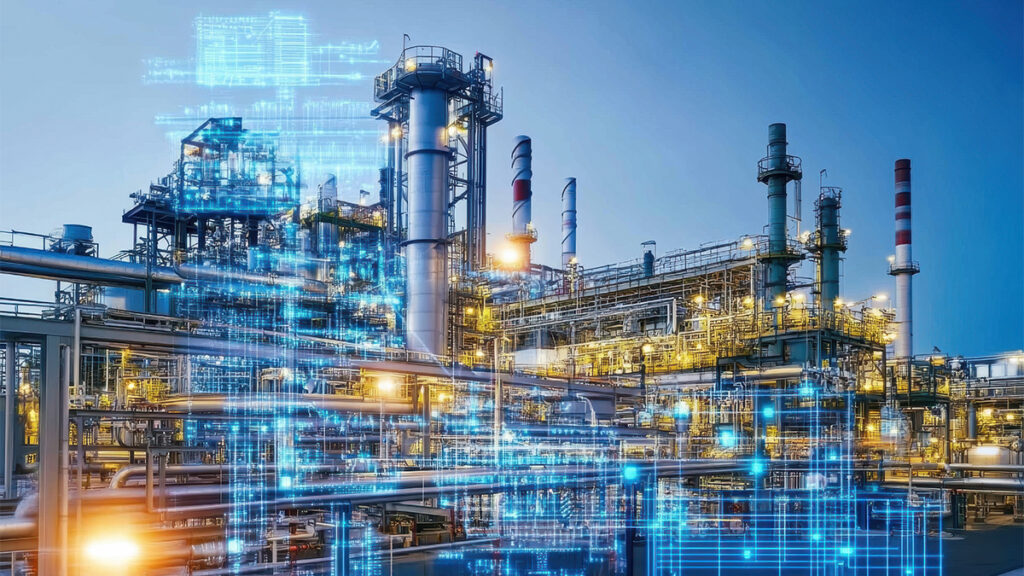Faced with rapid economic and population growth, India is investing tremendously in renewable and nuclear energy, as well as in the development of its oil fields and refining capacity. While the country has set a ‘Net Zero’ goal for 2070, energy security and the ability to provide affordable power to its 1.5 billion inhabitants remain the main priorities.
Director Pre-Sales
Hexagon, Assest Lifecycle Intelligence
How to supply reliable, affordable energy to 1.5 billion people while keeping emissions under control? This question is at the heart of India’s energy policy. While many Western countries focus primarily on energy transition, the country must pursue energy expansion to
This need has led to a dual track: building new renewable and nuclear capacity, and developing domestic oil and refining infrastructure, alongside stricter environmental regulation.
Technology plays a central role to ensure that this strategy succeeds. Improved project delivery, greater plant reliability and accurate emissions tracking are key to ensuring this strategy achieves both economical and environmental gains and positions India as an energy superpower.
The Rapid Rise of India’s Energy Demand
India’s energy consumption has increased by 20% since 2019, reaching 36.2 quadrillion BTU. That makes it the world’s third-largest energy consumer, behind the United States and China. Government projections expect another 35% rise over the next decade.
The country’s share of global greenhouse gas emissions has also grown—from 6.7% in 2019 to 7.8% in 2023. India has set a net zero target for 2070 and aims for half of installed electricity capacity to come from non-fossil sources by 2030.
This objective requires major investment in renewables. Solar capacity has recently surpassed 100 gigawatts, on par with Germany. Hydroelectric power is expected to rise by 50% by 2032, from 42 to 67 gigawatts. Nuclear capacity, currently 8 gigawatts, is also expanding, with six new reactors under construction.
Betting on Oil and Gas Expansion
At the same time as it boosts green energy, the country is also placing a major bet on oil production and refining.
Part of the reason is the growth of domestic demand: India will account for one-third of the global increase in oil consumption between now and 2030, according to the IEA. In addition, India imports more than 80% of the oil it consumes, making domestic production a strategic concern.
But India’s ambitions go beyond meeting domestic demand. The country has positioned itself as a major exporter of refined products, supplying Europe, Asia and the Middle East with over $80 billion of petroleum fuels, lubricants and petrochemicals annually.
This meeting of domestic needs, strategic concerns and economic ambitions has led to expand domestic oil production, with the country opening more than one million square kilometers to exploration in October 2024, with a tender for 16 blocks launched in February. The government is reforming its regulations to attract international players, largely absent from exploration and production. The Oilfield (Regulatory and Development) Amendment Bill, for example, simplifies environmental and land-use authorizations, frequent causes of delays in oil and gas projects.
A Matter of R&D
India is also seeking to make oil production cleaner, using advances in technology and applied research to limit environmental impact.
One example of this approach is Hexagon R&D India. Based in Hyderabad, the site is home to 2,100 engineers working across sensors, software and autonomous systems for energy and industry. It is the largest global research centre of Hexagon, whose technologies support more than half of all oil and gas processed worldwide.
This local presence has allowed Hexagon to support Indian clients in connecting their engineering, construction and maintenance systems. When data is centralised, changes in design or execution can be reflected accurately in digital models and documentation—reducing errors and delays. Tools such as HxGN EAM also help operators track emissions, optimise maintenance and reduce waste across the lifecycle of a plant.
In this domain, one of the areas producers are increasingly zeroing in on is the reduction of methane emissions. Methane, a gas with 28 times the warming potential of carbon dioxide, is a byproduct of oil and gas production that often escapes through leaks, venting or flaring, and has become a key target for emissions monitoring and control. Indian operators including ONGC have announced targets to reduce flaring and curb methane leaks, and monitoring tools are playing a growing role in supporting these goals.
The Crucial Role of Refineries
A crucial theater for India’s ambitions to grow energy supply without growing its emissions will be the country’s 23 refineries, which are crucial nodes in its energy system. As the backbone of India’s energy system, refineries are critical to ensuring energy availability. Any disruption can quickly lead to shortages Maintenance must be scheduled carefully to avoid holiday periods, when demand peaks. In October 2024, which included the Diwali festival, diesel consumption rose by 20% compared to September.
To keep pace with demand, India is investing heavily in refining capacity, ranking second globally behind China. But increasing output is only part of the strategy.
The country is also investing in digital tools to improve reliability and maintenance planning. Numaligarh Refinery Limited, the leading public facility in eastern India, is digitalising its operations, aiming to establish a digital twin as the definitive source of operational data.
The Making of a Global Energy Superpower
This focus on better data also supports tighter regulation. Refineries have undergone major upgrades to produce fuel compliant with Bharat Stage VI standards, which cut sulphur content to 10 parts per million—on par with the Euro 6 norm. As India takes on a larger role in global energy markets, this shift serves two goals.
For policymakers, it signals the country’s readiness to meet global expectations on environmental and operational standards. For energy companies, particularly multinationals expanding their footprint in India, it offers a model of how fossil fuel operations can evolve alongside renewables.
With a large and growing population, vast geography and limited electrification in key sectors— electric vehicles still represent just 2.5% of new car sales—India’s energy needs will remain high.
The government is not seeking to replace fossil fuels outright but to manage them more efficiently while scaling up alternatives. If its succeeds, India will become a laboratory for energy diversity, where fossil and renewable sources operate side by side to meet demand, reduce emissions and serve as a powerful foundation to the country’s economic growth.
Can India meet the challenge of providing net-zero electricity to one-fifth of the world’s population? The country has set the ambitious objective of achieving carbon neutrality by 2070 and, by 2030, bringing the share of non-fossil energy to 50% of installed electrical capacity.
This goal involves the development of renewable and low-carbon energy sources. India has recently passed the threshold of 100 gigawatts of solar capacity, equaling Germany.
Hydroelectric power is also expected to experience rapid growth, with the goal of increasing its installed capacity by half, from 42 gigawatts today to 67 by 2031–2032. Finally, nuclear energy, which currently represents 8 gigawatts or barely 2% of installed capacity, should also see this figure increase by half, thanks to six reactors under construction.
The Energy Transition Tested by Strategic Independence
At the same time, To meet the needs of its population, India is also accelerating its offshore oil exploration.
In the recent period, energy demand has risen sharply, driven by population and economic growth, urbanization, industrial expansion and the development of a more energy-intensive middle class. Its total primary energy consumption has increased by 20% since 2019, reaching 36.2 quadrillion Btu. This already places the country third in the world, behind the United States and China, and it is expected to grow by another 35% over the next ten years, according to government forecasts.
The result: in a world where consumption is expected to increase by 1.2 million barrels of oil per day by 2030, India alone accounts for a third of that increase, according to the IEA. Yet the country imports more than 80% of its oil, mainly from OPEC+ countries, the rest being supplied by the one million barrels per day of domestic production.
The increase in domestic field developments, described by Minister of Petroleum and Natural Gas, Mr. Hardeep Singh Puri as a ‘hundred-billion-dollar opportunity,’ is therefore as much a matter of strategic independence as it is of trade balance.
The objective of increasing domestic production has led to opening more than one million square kilometers to exploration in October 2024, with a tender for 16 blocks launched in February. The government is reforming its regulations to attract international players, largely absent from exploration and production. The Oilfield (Regulatory and Development) Amendment Bill, for example, simplifies environmental and land-use authorizations, frequent causes of delays in oil and gas projects.
India also hopes to chart a path toward a more environmentally respectful oil extraction, notably through stricter environmental standards for fuels and refined products—for example, the Bharat Stage (BS) VI emission standards, aligned with European Euro 6/VI norms.
The Hope for High-Tech, Greener Oil Extraction
On the production side, India faces a dual imperative. On the one hand, the country wants to move quickly to accelerate the exploration of its oil resources while global demand is at its peak. The country is already the third-largest exporter of refined products, with Europe among its main clients.
At the same time, it wants to avoid increasing its carbon footprint, as India’s share of global greenhouse gas emissions has already risen from 6.7% in 2019 to 7.8% in 2023. Energy players are counting on technological solutions to resolve this equation. For example, new exploitation projects now typically include digital twins from the design stage, intended to centralize information and measure greenhouse gas emissions throughout the lifecycle of future facilities.
A key target is methane emissions, a greenhouse gas responsible for a third of emissions in the energy sector, whose warming potential is considered 28 times greater than that of carbon dioxide. Several major players in the sector, including state-owned giant ONGC, have expressed their intent to tackle their methane emissions and to reduce harmful practices such as gas flaring.
Refinery Reliability Under Scrutiny
Another key focus of government attention: the country’s twenty-three refineries. Unlike Western countries, the growth in hydrocarbon demand comes from consumers rather than businesses.
The country’s development and the rise of the middle class have led to a surge in two main uses: transport (cars, motorcycles) and domestic consumption (especially for cooking).
As a result, Increasing Environmental Regulations
This greater traceability of information also aims to meet regulations that are developing to align with Western standards: oil distributors have massively invested in modernizing refineries to produce BS6-compliant fuel, with reduced sulfur content (10 ppm compared to 50 ppm under the BS4 standard), aligned with the Euro 6 norm.
As India plays an increasingly important role in the global energy industry, this alignment serves a dual purpose.
For public authorities, it is about proving that India is a major energy player, capable of aligning with the best environmental and operational practices and serving the entire world.
For major industry players—and particularly global giants who are increasingly present in India—the aim is to show that an alternative path exists to the decline of fossil fuels and their replacement by renewables.
With its growing population and economy, vast geography, and energy uses that are hard to replace with electricity—electric vehicles, for example, account for only 2.5% of new car sales— India faces significant energy challenges. To meet them, it intends to embody the perfect laboratory of ‘energy diversity,’ where fossil and renewable energies coexist sustainably as an alternative to the energy transition.


